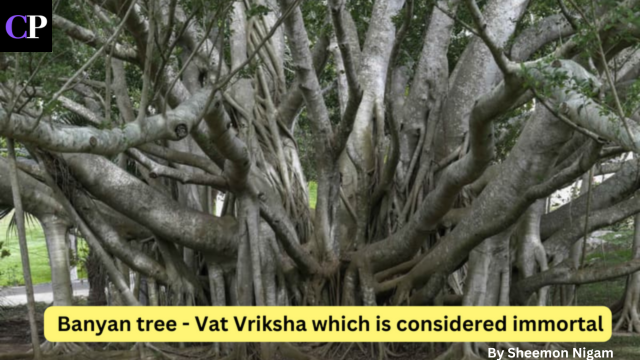Banyan tree – Vat Vriksha which is considered immortal

The Banyan tree or Vat Vriksha is one of the most important and sacred plants of the Hindu religion. Along with Ashwattha (peepal) and Tulsi, the banyan tree has great importance in the Hindu religion. The importance of the banyan tree has been written in almost every text of the Hindu religion. The amazing importance of the banyan tree has been mentioned not only in Hindu religion but also in Jainism and Buddhism.
Religious importance of the banyan tree
Although the scientific importance of the banyan tree is also very high, first let us talk about its religious importance. The Banyan tree is a symbol of Trimurti. Lord Vishnu resides in its bark, Supreme Father Brahma resides in its roots and Lord Shankar resides in its branches. According to Agni Purana, the banyan tree represents emanation and brightness, hence there is a tradition of worshiping this tree to have a child.
Form of Jatajuta Mahadev
The structure of the banyan tree is like matted hair, which is why in Shiv Purana it has been described as the form of Jatajuta Mahadev. Its philosophy has been described as that of Lord Rudra in person. In Padma Purana, it is also described as a form of Lord Vishnu, although Sri Hari is originally associated with Ashvattha (Peepal).
अश्वत्थरूपी विष्णु: स्याद्वरूपी शिवो यत:
Meaning: Peepal is in the form of Vishnu and Vat is Shiva in the form of Jata.
Symbol of immortality
This tree is also a symbol of immortality. It is considered immortal because the age of this tree is thousands of years. For this reason, it also has the name “Akshayvat”, that is, which does not decay. It is also said in some texts that apart from Kashi, only Akshayavat remains safe at the time of disaster.
We find a story about the origin of a banyan tree in Vaman Purana. In this text, Lord Brahma first appeared by taking a lotus flower from the navel of Lord Vishnu. After that, many trees and plants originated from the bodies of various gods. At the same time, the banyan tree originated from the king of Yakshas, Manibhadra. Since then the banyan tree has also been called by names like Yakshavas, Yakshatru, Yakshavaruka, etc.
यक्षाणामधिस्यापि मणिभद्रस्य नारद।
वटवृक्ष: समभव तस्मिस्तस्य रति: सदा।। – वामन पुराण
Bhandirvat story
In Harivansh Purana, there is a description of a banyan tree named “Bhandirvat”, enchanted by its beauty, Lord Krishna himself rested under it. In Ramayana, there is a description of a banyan tree named “Subhadravat” whose branch was broken by Garuda with his power. In the Ramayana itself, there is a description of the banyan tree named “Shyamanyagrodha”, which is currently famous by the name of Akshayavat and is one of the Panchayats. Shri Ram also spent a long time of his exile in Panchavati, which was named because of the five banyan trees present there.
There is also a belief that at the time of the cataclysm when the entire earth gets submerged, only one banyan tree is left on the earth. When the cataclysm ends, Lord Shri Hari appears in the form of an infant on the leaf of the same banyan tree. Their play is amazing, they are sucking their toe. Then a lotus flower arises from his navel on which the Supreme Father Brahma resides. At the same time, Brahmadev re-creates all the living beings.
Satyavan and Savitri is also important in the context of a banyan tree
The story of Satyavan and Savitri is also important in the context of a banyan tree. Satyavan’s life was taken by Yamraj under the banyan tree and then due to Savitri’s stubbornness and her husband’s vow, he revived him. Then Yamraj gave this boon to Savitri that the woman who worships the banyan tree on the day of Vat Savitri, her married life will be long. Since then there has been a tradition of observing Vat Savitri fast. Along with this, Savitri is also considered to reside in the banyan tree. You can read a detailed article on Vat Savitri here.
Importance of Vat Vriksha
It is believed that whoever plants a banyan tree escapes from the world of death and goes straight to Shivlok. Cutting a banyan tree is said to be equivalent to killing a son. According to Jainism, their first Tirthankar Lord Rishabhdev had completed his penance under the banyan tree. Similarly, according to Buddhism, Gautam Buddha attained enlightenment under the banyan tree in Gaya which is called the Bodhi tree.
Vat Vriksha also has scientific importance
Apart from religious beliefs, Vat Vriksha also has scientific importance. Banyan is one of the few trees that emit oxygen for more than 20 hours a day. According to Ayurveda, the Banyan tree is very effective in controlling the three main components of the body – Vata, Pitta, and Kapha. Many medicines are made from its bark and leaves. The banyan tree keeps the air around it pure. Apart from this, it is also considered the basis of life because innumerable living beings survive on its huge branches. On this, they get both house and food.
National tree of India
The Banyan tree is also the national tree of India. The world’s oldest banyan tree is considered to be “Akshayvat” located in Prayagraj, which is present from the Ramayana period till today. The world’s largest banyan tree is the banyan tree named “Thimamma Marrimanu” located in the Anantapur district of Andhra Pradesh, which is so huge that its shadow extends to about five acres. In 1989 it was recorded in the Guinness Book and World Records.
In the context of a banyan tree, we get the description of “Panchvatas” which have been present from ancient times till today. These are – Akshayavat, Panchavat, Vanshivat, Gayavat and Siddha Vat. We will talk about these in detail in another article.